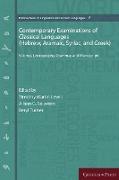- Start
- Contemporary Examinations of Classical Languages (Hebrew, Aramaic, Syriac, and Greek)
Contemporary Examinations of Classical Languages (Hebrew, Aramaic, Syriac, and Greek)
Angebote / Angebote:
Ancient language study is becoming an increasingly sophisticated and complex discipline, as scholars not only consider methods being used by specialists of other languages, but also absorb developments in other disciplines to facilitate their own research investigations. This interdisciplinary approach is reflected in the scope of research papers offered here, invited and peer-reviewed by the ISLP.The volume is presented in three parts.Part 1: Examining Verbs: Putting Syntax into Lexica and Grammars. Beryl Turner and Jerome Lund demonstrate how the use (or non-use) of certain prepositions impacts on the semantics of some Syriac verbs. In chapters 3 to 5 verbal valency in Biblical Hebrew is examined. Janet Dyk demonstrates how scholars might identify the semantics of a Hebrew verb by examining its co-occurring elements. John A. Cook demonstrates the superiority of a valency approach over traditional grammatical approaches and distinguishes between valency, voice, and transitivity. Nicolai Winther-Nielsen explains how he utilises the theory of Role and Reference Grammar (RRG) to analyse the frequently-used Biblical Hebrew verbs. A. Dean Forbes identifies several theoretical issues that remain unsolved and potentially unsolvable in valency studies.Part 2: Examining Particles: Lexical Correspondences.Mats Eskhult examines the use of Syriac ¿¿¿ in rendering Hebrew ¿¿¿¿¿¿ and Greek ¿δο¿ or ¿δε in the Peshitta to Genesis and the Gospels. Na'ama Pat-El argues that ¿¿/¿¿¿ is not a quotative marker as commonly assumed but is probably an emphatic adverb.Part 3: Examining Manuscripts and Text-Critical Matters. Jonathan Loopstra examines patterns of accentuation in BL Add. MS 12138 (the East-Syrian "Masora"). Jeff Childers explores the illicit practice of sortilege as applied to Syriac, Greek, Latin, Coptic, and Armenian versions of John's Gospel. Alison Salvesen examines how the early seventh century Syriac translator rendered items in the Tabernacle described in Exodus. Johan D. Hofstra provides an extensive study of the sources used by Isho'dad of Merw in composing his Syriac commentary on the Gospel of John. In the final chapter, Jerome A. Lund demonstrates how Hebrew manuscripts of Isaiah can assist in making emendations to the extant Syriac text of Isaiah.
Folgt in ca. 15 Arbeitstagen
